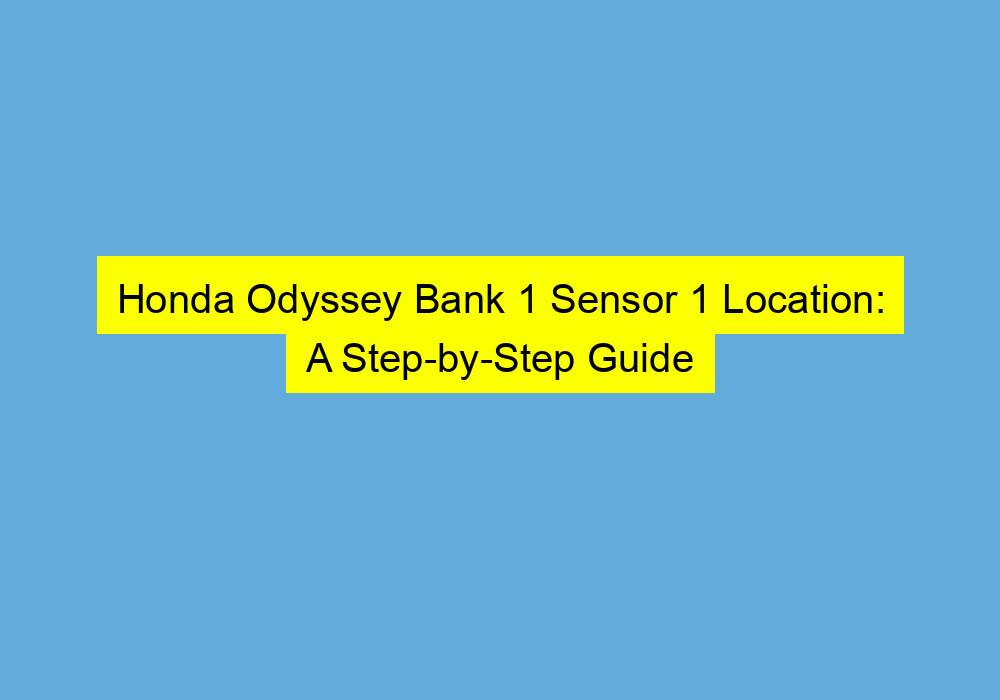If you own a Honda Odyssey, you may encounter some troubles with its engine performance. One of the most common issues you can experience is a faulty Bank 1 Sensor 1, which can cause an incorrect air-fuel ratio and inefficient engine combustion. To address this problem, you need to identify the location of Bank 1 Sensor 1 and replace it promptly to prevent any further engine damage.
The Bank 1 Sensor 1 is an essential component of your Honda Odyssey’s emission system. It measures the oxygen content in the vehicle’s exhaust gas and sends signals to the engine control module (ECM), adjusting the air-fuel ratio to maintain optimal combustion. However, if the sensors fail or get faulty, your engine performance will deteriorate, causing reduced fuel economy, increased emissions, and poor acceleration. To avoid these issues, you need to know where to find your Honda Odyssey’s Bank 1 Sensor 1 and replace it when necessary.
Understanding Bank 1 Sensor 1 in Honda Odyssey
Banks and sensors may sound complicated, but in the world of automobiles, they are used to keep the engine in perfect condition. If you own a Honda Odyssey, you might get curious about the Bank 1 Sensor 1, especially when there’s a problem in the engine. Understanding the Bank 1 Sensor 1 in Honda Odyssey is easy, and we’re here to help.
- What is Bank 1?
Bank 1 refers to the side of the engine that has the first cylinder. In Honda Odyssey, Bank 1 is found on the driver’s side. - What is Sensor 1?
Sensor 1 refers to the sensor that is placed upstream or before the catalytic converter. The role of the sensor is to measure the oxygen level in the exhaust gas, which is used by the engine computer to adjust the air-to-fuel ratio. Sensor 2 or downstream sensors are found after the catalytic converter. - What is the function of Bank 1 Sensor 1?
The role of Bank 1 Sensor 1 in Honda Odyssey is to measure the oxygen level in the exhaust gas as mentioned earlier. The measurements are used to determine if the air/fuel ratio is rich or lean. If Bank 1 Sensor 1 fails to function correctly, it can cause various issues in the performance of the engine.
Problem |
Symptoms |
|---|---|
A failed or malfunctioning Bank 1 Sensor 1. |
The Check Engine light turns on, the poor acceleration of the vehicle, reduced fuel economy, and engine misfire. |
Honda Odyssey’s Bank 1 Sensor 1 is a significant part of the engine’s performance, and if it fails, it can cause several issues. There’s no need to panic because replacing the Bank 1 Sensor 1 is not a complicated task. You can either take your Honda Odyssey to a professional mechanic or replace it yourself if you have the right tools and some knowledge of car maintenance. There are plenty of manuals available online to guide you through the process of changing the Bank 1 Sensor 1 in Honda Odyssey.
Importance of Bank 1 Sensor 1 in Honda Odyssey
Bank 1 Sensor 1 is an essential component of Honda Odyssey’s engine system, measuring the oxygen level of the engine’s exhaust and communicating this information to the engine control module (ECM). The ECM uses this data to adjust the air-fuel mixture to optimize engine performance, improve fuel efficiency, and reduce harmful emissions. In this subtopic, we will discuss the importance of Bank 1 Sensor 1’s functioning and its impact on the Honda Odyssey’s engine system.
- Engine Performance: Bank 1 Sensor 1 plays a critical role in maintaining the engine’s optimal performance. If the oxygen level in the exhaust is too high or too low, the ECM signals the fuel system to adjust the air-fuel ratio. This adjustment ensures that the engine receives the correct fuel mixture and operates smoothly at all times. If Bank 1 Sensor 1 fails to report the accurate oxygen level of the exhaust, the ECM may not receive correct data, leading to poor engine performance, which can manifest as a rough idle or difficulties accelerating.
- Fuel Efficiency: The proper functioning of Bank 1 Sensor 1 also improves fuel efficiency. If the air-fuel mixture is too lean or too rich, the engine’s performance can suffer, reducing its fuel efficiency. The ECM uses the data provided by Bank 1 Sensor 1 to maintain the correct air-fuel mixture, ensuring optimal engine performance and fuel economy. A failing Bank 1 Sensor 1 can cause a decrease in fuel efficiency and lead to higher fuel consumption and carbon dioxide emissions.
- Emissions: The Honda Odyssey’s engine produces emissions that can harm the environment and human health. The efficiency of the emission control system is closely related to the data provided by the Bank 1 Sensor 1. With the right fuel mixture, the engine produces less pollution, and the catalytic converter can convert harmful gases into less harmful ones. Therefore, the proper function of Bank 1 Sensor 1 is vital to reduce the amount of pollution emitted by the Honda Odyssey and comply with environmental regulations.
It is essential to ensure that Bank 1 Sensor 1 is functioning correctly to maintain the Honda Odyssey’s overall performance and protect the environment. A failing Bank 1 Sensor 1 can lead to a poorly running engine and reduced fuel economy. When the check engine light illuminates, indicating a possible issue with the oxygen sensor, the vehicle’s owner should seek professional help immediately. A faulty oxygen sensor can negatively impact the engine’s function and affect other crucial components of the vehicle.
Sign of Failing Bank 1 Sensor 1 |
Possible Effects |
|---|---|
Misfires, Stalling, Rough Idle |
If the engine is not receiving the correct air-fuel ratio, it may cause the engine to stall or misfire. A rough idle can also be particularly noticeable when the engine is at low RPMs. This will lead to less performance and more issues in the future. |
Increase in Emissions |
A failed Bank 1 Sensor 1 can cause harmful gases to be released into the environment, which will cause pollution and harm the environment. |
Poor Fuel Economy |
A failing Bank 1 Sensor 1 will alter the air-fuel ratio, which can lead to poor fuel efficiency. This means you will get fewer miles per gallon and have to refuel more frequently. |
Symptoms of Bank 1 Sensor 1 Failure in Honda Odyssey
The Bank 1 Sensor 1 in a Honda Odyssey is an important part of the engine’s emission control system. It is responsible for monitoring the air-fuel mix of the engine and sending information to the vehicle’s computer so that it can adjust the fuel system and maintain the proper air-fuel ratio. When the Bank 1 Sensor 1 fails, it can cause a number of problems, some of which are listed below:
- Poor fuel economy: One of the first signs of a failing Bank 1 Sensor 1 is poor fuel economy. Since the sensor is responsible for monitoring the air-fuel ratio, a faulty sensor can cause the vehicle to burn more fuel than necessary.
- Lack of power: Another common symptom is a lack of engine power. This is because the sensor is unable to monitor the air-fuel ratio accurately and the engine is unable to perform at peak efficiency.
- Check engine light: If the Bank 1 Sensor 1 fails, it can cause the check engine light to come on. The vehicle’s computer will store a trouble code that indicates the sensor is not functioning properly. It is important to have the code checked as soon as possible to prevent further damage to the engine.
In addition to these symptoms, a faulty Bank 1 Sensor 1 can also cause other problems with the engine. It is important to have the sensor checked and replaced as soon as possible if any of these symptoms occur.
Symptom |
Cause |
Solution |
|---|---|---|
Poor fuel economy |
Failing Bank 1 Sensor 1 |
Replace the sensor |
Lack of power |
Failing Bank 1 Sensor 1 |
Replace the sensor |
Check engine light |
Failing Bank 1 Sensor 1 |
Check the trouble code and replace the sensor |
It is important to note that a faulty Bank 1 Sensor 1 can also cause damage to the catalytic converter. This is because the sensor is responsible for ensuring that the engine operates at peak efficiency, which is necessary for the catalytic converter to function properly. If the sensor is not working, it can cause the engine to run too rich or too lean, which can damage the catalytic converter over time.
In conclusion, a failing Bank 1 Sensor 1 in a Honda Odyssey can cause a number of problems with the vehicle’s engine. If any of the symptoms described above occur, it is important to have the sensor checked and replaced as soon as possible to prevent further damage to the vehicle.
How to Check Bank 1 Sensor 1 in Honda Odyssey
If you have been experiencing issues such as failed emissions tests, poor gas mileage, or an illuminated Check Engine light on your Honda Odyssey, it could be due to a faulty Bank 1 Sensor 1. This sensor is responsible for monitoring the oxygen content in the exhaust and ensuring that the air-to-fuel ratio is at the optimal level for efficient engine performance. In this article, we will dive into the specifics of how to check Bank 1 Sensor 1 in your Honda Odyssey.
- Inspect the wiring: Before jumping to conclusions and replacing the sensor altogether, it is best to inspect the wiring connections between the sensor and the engine control module. Oftentimes, loose or damaged wires can cause the sensor to malfunction and throwing off the air-to-fuel ratio. If you find any damaged wires, the best course of action is to replace the entire sensor.
- Look for signs of wear and tear: Bank 1 Sensor 1 is located in the exhaust manifold of your Honda Odyssey, which means it is exposed to high levels of heat and debris from the road. Over time, the sensor can become corroded, stripped, or simply worn out from constant exposure to these elements. Take a close look at the sensor to see if there are any visible signs of damage or wear and tear. If you do notice any of these issues, the sensor should be replaced as soon as possible.
- Check the voltage output: One of the most reliable ways to check the function of Bank 1 Sensor 1 is to test the voltage output with a multimeter. This tool can provide real-time data on the output of the sensor, giving you an accurate insight into whether or not it needs to be replaced. Ideally, the voltage output should be between 0.1V and 0.9V with a warm engine idle. If the voltage output is outside of this range, there is a good chance the sensor needs to be replaced.
Once you have performed these initial checks on your Honda Odyssey, you may have a better idea of whether or not Bank 1 Sensor 1 is functioning correctly. If you are still unsure, it may be time to bring your vehicle into a trusted mechanic or dealership for a more in-depth analysis.
Issues related to a faulty Bank 1 Sensor 1 |
Possible solutions |
|---|---|
Failed emissions tests |
Replace the Bank 1 Sensor 1 |
Poor gas mileage |
Replace the Bank 1 Sensor 1 |
Illuminated Check Engine light |
Inspect wiring connections, look for signs of wear and tear, test voltage output, replace sensor if necessary |
While it can be daunting to diagnose and repair issues with your vehicle, taking the time to check Bank 1 Sensor 1 in your Honda Odyssey can save you money and hassle in the long run. By keeping an eye on this crucial sensor and addressing any issues as soon as possible, you can ensure that your vehicle is running smoothly and efficiently for years to come.
Guide to Replace Bank 1 Sensor 1 in Honda Odyssey
The Bank 1 Sensor 1 is an essential component of the Honda Odyssey’s engine management system that detects the amount of oxygen in the exhaust gas. If this sensor fails, the engine’s performance could be affected, or the check engine light may turn on. Replacing the Bank 1 Sensor 1 is a relatively easy task that can be completed with a few tools. Here is a guide to help you replace the Bank 1 Sensor 1 in your Honda Odyssey.
- Determine which sensor needs to be replaced: Depending on the engine, the Honda Odyssey has two or four oxygen sensors. Bank 1 Sensor 1 is located on the side of the engine where Cylinder 1 is situated. It is the first sensor in the exhaust system that is closer to the engine.
- Prepare the tools: You will require a jack, jack stands, oxygen sensor socket or adjustable wrench, penetrating oil, and anti-seize compound.
- Locate the sensor: Start by locating the Bank 1 Sensor 1. It is usually on top of the exhaust manifold. However, this may vary based on the Honda Odyssey’s model year. Consult the owner’s manual or a repair guide if unsure.
Once you have located the sensor, follow these steps to replace the Bank 1 Sensor 1:
Step |
Action |
|---|---|
1 |
Turn off the engine and allow it to cool down. Do not attempt to replace the sensor if the engine is hot. |
2 |
Use a jack and stands to prop up the front end of the Honda Odyssey. This will make it easier to reach the sensor from underneath. |
3 |
Spray penetrating oil on the sensor’s threads and allow it to soak for some time to make it easier to loosen the sensor. |
4 |
Disconnect the sensor’s wiring harness and remove it from the exhaust manifold using an oxygen sensor socket or an adjustable wrench. Turn the sensor counterclockwise to loosen it, and carefully remove it once it’s loose. |
5 |
Clean the sensor’s threads using a wire brush. Apply anti-seize on the threads of the new sensor before installing it. Tighten the new sensor by turning it clockwise using the oxygen sensor socket or adjustable wrench. |
6 |
Reconnect the wire harness to the new sensor. |
7 |
Crank the engine to confirm whether the new sensor is functioning correctly. If the sensor replacement is successful, the check engine light should turn off. |
Replacing the Bank 1 Sensor 1 in your Honda Odyssey is a simple process that should not take more than an hour. However, there are some precautions you need to take to ensure that the sensor is accessible and cannot lead to damage to other components. Ensure that you use quality parts and have all the required tools before beginning the replacement process.
- Additional precautions:
- Work on the sensor when the engine is cool. A hot engine exhaust system can be dangerous and can cause burns.
- If the sensor is not too tight, remove it with your hands without using a wrench. This ensures that the wires connecting the sensor do not become severed.
- Use OEM or high-quality replacement components to ensure that the Honda Odyssey’s engine performance is not affected.
Following these precautions and guidelines will ensure that you replace the Bank 1 Sensor 1 safely and successfully. Regular maintenance of the Honda Odyssey’s engine management components can ensure a smooth driving experience and help prevent breakdowns.
Tools Required to Replace Bank 1 Sensor 1 in Honda Odyssey
If you’re experiencing problems with your Honda Odyssey engine, it could be due to a faulty oxygen sensor. The first indication of a malfunctioning oxygen sensor is the warning light on your dashboard, which could mean that the Bank 1 Sensor 1 is faulty. The oxygen sensor is essential in measuring the oxygen levels in the exhaust system and relaying this data to the engine computer, which adjusts the fuel and air mixture for optimum performance. If your engine is consuming more fuel than usual or has reduced power, the oxygen sensor could be broken, and you need to replace it. Replacing the faulty Bank 1 Sensor 1 in your Honda Odyssey can prolong the life of the engine and prevent further damage. Here are the tools required to replace the Bank 1 Sensor 1 in your Honda Odyssey.
- Screwdriver: The first tool you need to replace your Honda Odyssey’s Bank 1 Sensor is a screwdriver. The screwdriver will help you remove the retaining clips that hold the sensor to the exhaust pipe. You might also need a socket wrench if the clips are attached with bolts.
- Jack: The Honda Odyssey has a low ground clearance, and you need to jack the vehicle to reach the oxygen sensor. A hydraulic jack can lift the car with ease, and jack stands will hold the vehicle in position. Ensure the car is stable before starting the repair process.
- Wire Cutters: The Honda Odyssey oxygen sensor is connected to the vehicle’s electrical system. You need wire cutters to cut the sensor’s electrical wires from the wiring harness. This can be done easily since the wires are color-coded and clearly labeled. The wire cutters will cut the wires clean, making the replacement process easier.
Once you have these tools, you’re ready to start the repair process. Here are the steps you can follow to replace the Bank 1 Sensor 1 in your Honda Odyssey.
Step |
Description |
|---|---|
Step 1 |
Locate the Bank 1 Sensor 1. It is typically located on the exhaust manifold or the front exhaust pipe. Raise the front end of the vehicle using the jack and jack stands and secure the car in position. |
Step 2 |
Disconnect the electrical connector from the Bank 1 Sensor 1. Use your wire cutters to snip the wires from the sensor without damaging the harness. |
Step 3 |
Loosen the sensor clips or bolts holding the Bank 1 Sensor 1 to the exhaust pipe using the screwdriver or socket wrench. |
Step 4 |
Remove the faulty Bank 1 Sensor 1 from the vehicle. You might require a little force to break the sensor loose from the exhaust pipe, but be careful not to damage other parts of the exhaust manifold. |
Step 5 |
Install the new Bank 1 Sensor 1 in the same position as the faulty one. Tighten the sensor clip or bolt to hold the sensor in place. |
Step 6 |
Plug in the electrical connector into the new Bank 1 Sensor 1 and ensure that the wires are correctly connected. You can use a multimeter to test the new sensor and confirm that it’s working correctly. |
Replacing the Honda Odyssey Bank 1 Sensor 1 is an easy process that you can do at home with minimal tools. Not replacing the sensor might lead to a decrease in engine performance, reduced fuel economy, and increased emissions. It’s recommended that you replace the Bank 1 Sensor 1 at the first indication of the Check Engine light coming on. With the right tools and some basic mechanical knowledge, you can tackle this repair at home.
Honda Odyssey Bank 1 Sensor 1 Location Explained
If you own a Honda Odyssey and have been experiencing issues with your engine, one of the first things you may want to check is the location of the Bank 1 Sensor 1. This sensor plays a crucial role in your car’s emission system and fuel management, so determining its precise location is essential.
Here are seven essential things you need to know about Honda Odyssey Bank 1 Sensor 1 Location.
- Understanding Your OBD System: OBD stands for Onboard Diagnostics. Every modern-day car comes with an OBD system that monitors different aspects of the vehicle’s performance. This system is made up of distinct monitors that track different parts of the car’s performance, including fuel efficiency, emissions, and overall engine health. The OBD system will automatically notify the driver if there is a problem detected. When this happens, the OBD system will display a fault code that can be read using a diagnostic reader or scanner.
- What is Bank 1 Sensor 1? The Honda Odyssey has a V6 engine with two banks: Bank 1 and Bank 2. Bank 1 Sensor 1 refers to the oxygen sensor on the first bank of cylinders, located before the catalytic converter. This oxygen sensor plays a crucial role in monitoring the air-fuel mixture in the engine. If there is an issue with the air-fuel ratio, the sensor will send an error signal to the OBD system.
- Where is the Bank 1 Sensor 1 located? The Bank 1 Sensor 1 is located on the passenger’s side of the vehicle. You can find it on the exhaust manifold, just to the rear of the catalytic converter.
- Identifying the Right Sensor: Finding the Bank 1 Sensor 1 can be challenging, especially if you are not familiar with the car’s engine layout. One of the keys to locating the sensor is to look for a wire running from the sensor to the car’s main wiring loom. The plug on the end of this wire is usually blue and easily visible from the top of the engine’s bay.
- Common Signs of a Failing Bank 1 Sensor 1: When the Bank 1 Sensor 1 goes bad, it can cause a range of engine issues. In most cases, you will receive an error message on your car’s dash, indicating a problem with the OBD system. Other signs of a failing sensor include poor fuel economy, rough idle, and a drop in engine performance. Replacing the sensor will usually fix these issues.
- Replacing Bank 1 Sensor 1: Replacing the Bank 1 Sensor 1 is a straightforward process if you have a bit of mechanical knowledge. However, if you are not comfortable working with cars, we recommend that you take your car to a professional mechanic. The sensor is located at the front of the engine bay, behind the radiator. Once you find it, remove the wiring clip and unscrew the sensor using a wrench. You can then replace it with a new sensor, tighten it down, and reattach the wiring clip.
- How to Maintain Your Oxygen Sensors: The oxygen sensors on your car are a crucial part of its emission system. So it’s essential to keep them in good condition. One of the best ways to maintain your oxygen sensors is to change your oil regularly. Dirty oil can contaminate the sensors and lead to poor performance. Additionally, you should avoid using ethanol-blended fuel in your car, as this can also damage the sensors over time.
If you are not confident in your ability to identify or replace the Bank 1 Sensor 1, we recommend seeking the assistance of a professional mechanic. Replacing the sensor can be an intensive job, requiring specialized tools and equipment. However, if you do decide to tackle the job yourself, make sure to follow the manufacturer’s instructions and take your time to avoid damaging any other parts of the car.
Pros of Replacing Bank 1 Sensor 1: |
Cons of Replacing Bank 1 Sensor 1: |
|---|---|
Increase in fuel efficiency |
Cost of replacement |
Improved engine performance |
Difficulty of DIY replacement |
Elimination of warning light |
Potential for additional repairs |
Replacing the Bank 1 Sensor 1 can have a range of positive effects on your car’s overall performance. However, it’s important to weigh the benefits against the cost of replacement and any potential additional repairs that may be needed. By following the manufacturer’s instructions and incorporating regular maintenance, you will help to ensure the ongoing health and performance of your Honda Odyssey’s emission system.
Common Issues with Bank 1 Sensor 1 in Honda Odyssey
The Honda Odyssey Bank 1 Sensor 1 or the upstream oxygen sensor is responsible for monitoring the air-fuel mixture of the engine. A faulty sensor can cause numerous problems in the vehicle’s performance. Here are the common issues with Bank 1 Sensor 1:
- Rough idling: A faulty sensor can disrupt the fuel and air mixture, which can lead to rough idling. The engine may feel shaky or unsteady, especially when stopped.
- Poor fuel economy: A malfunctioning sensor may not accurately transmit data to the engine’s computer, which can lead to an unbalanced air-fuel ratio. As a result, the engine could end up consuming more fuel than necessary, resulting in poor fuel economy.
- Check engine light: The check engine light is a warning sign that there is a problem with the engine. A broken sensor can trigger this light to display. It is essential to have this issue checked by a mechanic to avoid further damage.
Several reasons can cause the Bank 1 Sensor 1 in Honda Odyssey to fail, such as:
- Age: After a few years, the oxygen sensor may wear down or become less efficient in detecting the air-fuel mixture. As a result, it may start to read inaccurate data, which can lead to performance issues.
- Dirt or contaminants: The sensor could become clogged with dirt or other contaminants in the environment. This can obstruct its ability to detect the air-fuel mixture accurately.
- Oil or coolant contamination: The sensor may become contaminated with oil or coolant, which can harm its functionality.
If you have noticed any of the above signs or suspect an issue with your Honda Odyssey’s Bank 1 Sensor 1, it is essential to have it checked by a qualified mechanic. The issue can be resolved by either cleaning or replacing the sensor, depending on its condition.
YEAR |
ENGINE SIZE |
LOCATION |
|---|---|---|
1995-1998 |
2.2L, 2.3L |
Bank 1 Sensor 1 is located on the exhaust manifold behind the catalytic converter. |
1999-2004 |
3.5L |
Bank 1 Sensor 1 is located on the exhaust manifold in front of the catalytic converter. |
2005-2010 |
3.5L, 2.4L |
Bank 1 Sensor 1 is located on the exhaust manifold in front of the catalytic converter. |
2011-2017 |
3.5L, 3.6L, 2.4L |
Bank 1 Sensor 1 is located on the exhaust manifold in front of the catalytic converter. |
2018-Present |
3.5L, 3.6L |
Bank 1 Sensor 1 is located on the exhaust manifold in front of the catalytic converter. |
Knowing the location of Bank 1 Sensor 1 in your Honda Odyssey is crucial, especially if you plan on checking or replacing it yourself. However, it is always best to leave the task to a certified mechanic.
Tips to Ensure Proper Functioning of Bank 1 Sensor 1 in Honda Odyssey
If you own a Honda Odyssey, you know that it’s an exceptional car designed with top-of-the-line features that make it an excellent family van. One of such features is the Bank 1 Sensor 1. This device helps regulate the vehicle’s fuel efficiency and keeps the engine running smoothly. However, it’s crucial to ensure that the sensor works correctly to avoid any engine problems. In this article, we will discuss essential tips to ensure the proper functioning of Bank 1 Sensor 1 in Honda Odyssey.
-
- Regular maintenance of your Honda Odyssey
The first and most crucial tip to ensure the proper functioning of Bank 1 Sensor 1 in Honda Odyssey is regular maintenance. Regular maintenance is a fundamental aspect of keeping your car in top shape. Something as simple as a dirty air filter or a loose gas cap can cause problems that can lead to the sensor’s failure. Therefore, it’s essential to schedule regular maintenance with a certified Honda mechanic. During routine maintenance, they will check the sensor’s condition and clean or replace it if necessary.
-
- Use high-quality fuel
Sometimes, the culprit behind Bank 1 Sensor 1’s failure can be low-quality fuel. Using low-quality fuel can cause a buildup of deposits on the sensor, leading to its failure. Therefore, it’s important to use high-quality fuel in your Honda Odyssey. High-quality fuel burns cleanly and reduces the risk of deposit buildup on the sensor. This way, you can ensure that the sensor is functioning correctly and avoid any engine problems.
-
- Avoid aggressive driving
Another important tip to ensure the proper functioning of Bank 1 Sensor 1 in Honda Odyssey is avoiding aggressive driving. Driving aggressively, such as accelerating or braking suddenly, can cause a strain on the car’s engine, leading to the sensor’s failure. Therefore, it’s important to drive your Honda Odyssey in a calm and steady manner. This way, you avoid any extra pressure on the engine and keep the sensor functioning correctly.
Aside from the tips mentioned above, it’s important to know the Bank 1 Sensor 1’s location in your Honda Odyssey. The Bank 1 Sensor 1 is located on the exhaust manifold, near the engine block’s front. This position is critical to ensure that the sensor functions correctly, as it helps regulate the vehicle’s fuel efficiency. However, faults can still occur. Here’s a table of some typical signs of sensor failure:
Sign of Sensor Failure |
Possible Cause |
Solution |
|---|---|---|
The Check Engine Light is on |
A malfunction in the sensor’s system |
Check the sensor’s condition and replace if necessary |
Poor Fuel Efficiency |
Faulty sensor |
Have the sensor checked and, if necessary, replaced |
The vehicle is emitting black smoke from the exhaust |
The sensor is providing incorrect readings |
Have the sensor checked and, if necessary, cleaned or replaced |
In conclusion, the Bank 1 Sensor 1 is a critical feature of your Honda Odyssey, and its proper functioning is crucial to avoid engine problems. By following the tips above, you can ensure that the sensor works correctly and get the most out of your car.
Troubleshooting Bank 1 Sensor 1 issues in Honda Odyssey
If you’re driving a Honda Odyssey, you know how essential it is to have all the components in good working condition. One vital component in your vehicle is the oxygen or O2 sensor, specifically the Bank 1 Sensor 1. The Bank 1 Sensor 1 is responsible for measuring the oxygen level in the exhaust gases of your Honda Odyssey and relaying it to the engine’s computer. This feedback helps your car control the fuel-to-air ratio for optimal vehicle performance. However, if the Bank 1 Sensor 1 fails or malfunctions, it can lead to some troubling issues. In this article, we will explore the common signs of Bank 1 Sensor 1 issues and how to troubleshoot them.
Here are ten potential issues to watch out for:
- The Check Engine Light comes on: Once your Honda Odyssey’s engine computer detects an issue with the Bank 1 Sensor 1, the Check Engine Light (CEL) illuminates. There are several other sensors that might trigger the CEL, but a diagnostic code reader can determine if Bank 1 Sensor 1 is the problem.
- Poor Fuel Efficiency: The Bank 1 Sensor 1’s primary job is to monitor the oxygen levels in the exhaust and then inform the engine computer to adjust the fuel-to-air ratio. If the sensor is malfunctioning, then the engine receives incorrect signals, resulting in poor fuel economy.
- Engine misfires: When the Bank 1 Sensor 1 fails, it can cause the engine to misfire or stall, or have poor acceleration during drives.
If you experience any of these issues, it signifies a faulty Bank 1 Sensor 1. So, what can you do in such a situation? Let’s look at the following troubleshooting steps:
Step 1: Check the Connections and Wires
The first step is to check the connections and wires leading to the sensor. In some cases, it might be loose or disconnected, leading to a weak signal. You can check the connections under the hood by jiggling them for excessive play or corrosion. If there is any issue with the connections, then replacing them might solve the problem.
Step 2: Clean the Sensor
The Bank 1 Sensor 1 could be dirty, and cleaning it up can help restore its performance. Start by removing the sensor from the exhaust manifold and cleaning it with an appropriate cleaning solution. After cleaning, make sure that the sensor is dry before reinstalling it.
Step 3: Replace the Sensor
If cleaning or checking the connections doesn’t help, then replacing the Bank 1 Sensor 1 might be necessary. It’s essential to use a compatible sensor for your Honda Odyssey and install it correctly for optimal performance.
Problem |
Troubleshooting Steps |
|---|---|
The Check Engine Light comes on |
Use a diagnostic code reader to identify the problem with the sensor, and replace it if necessary. |
Poor Fuel Efficiency |
Check the sensor’s connections, clean it, or replace the sensor if needed. |
Engine misfires |
Check the sensor’s connections, clean it, or replace the sensor if needed. |
In conclusion, taking good care of your Honda Odyssey’s Bank 1 Sensor 1 can keep it running smoothly. With some fundamental troubleshooting steps, you can identify and fix any potential issues with the sensor. Remember always to use compatible parts and follow the manufacturer’s instructions to avoid further problems. Keeping your car in good condition not only helps save you money, but it also ensures your safety on the road.
Thank You for Reading!
We hope this article about the Honda Odyssey Bank 1 Sensor 1 Location was informative and helpful for you. Remember to check your owner’s manual or consult with a professional mechanic if you’re experiencing any issues with your vehicle’s oxygen sensors. We’ll keep sharing more car-related tips and tricks that can make your life easier, so make sure to come back soon. Drive safe and happy motoring!





